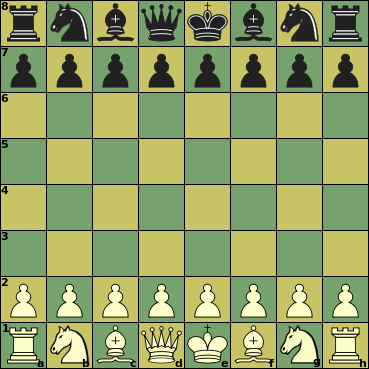Suicide Chess
 |
Initial setupe1, e8: King |
Moves at a Glance
Click on a piece below to see its moves
 |
 |
 |
 |
Sliding capture or non-capture, can be blocked on any square along the ray |
|||||||
 |
Unblockable leap (capture or non-capture) | ||||||||||
 |
Non-capture only | ||||||||||
 |
Capture only | ||||||||||
 |
 |
 |
 |
 |
 |
 |
|||||
 |
|||||||||||
:
:
:
:
| Piece | ID | value | Moves (Betza notation) | Remarks |
| King | K | - | K | Can castle with Rook, moving 2 steps towards it |
| Queen | Q | 6 | RB or Q | |
| Rook | R | 4 | R | |
| Bishop | B | 3 | B | Color-bound |
| Knight | N | 3 | N | |
| Pawn | P | 1 | mfWcfF | Promotes to K, Q, R, B, or N on reaching last rank |
Pawn peculiarities
- Pawns capture differently from how they move (straight move, diagonal capture).
- Pawns can move two squares straight ahead from their initial position, provided they are not blocked.
- On the move immediately after such a double push, they can be captured en passant by another Pawn, as if they had only moved 1 square ahead.
- Pawns promote to another piece of choice (including King) when they reach last rank.
Castling
A King that has not moved before can move two squares in the direction of a Rook that has not moved before, in which case that Rook is moved to the square the King skipped over. This is only allowed if all squares between King and Rook are empty.
General rules
- Capture is mandatory; if ay capture is possible, you cannot play a non-capture.
- The game is won by the side that has no legal moves (usually because he has no pieces left).
Differences with FIDE
The King is not special in any way, and can be captured like any other piece. Hence the concept of 'check' does not exist. Pawns can promote to King.
Strategy issues
The King is actually a good choice for a promotion piece, as it is not so easy for the opponent to feed a lot of material to a King.